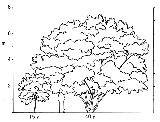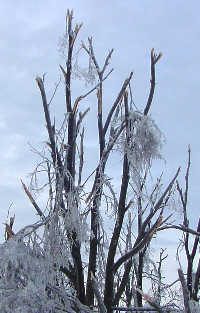



amur maple
Acer tataricum spp. ginnala
Amur maple is a small tree - large shrub with a mature height of 20 to 30 feet with spread equal to wider. This tree is appropriate for all yards, parks. It can be allowed to form multi-stem shrubs or trained to a single stem. The specie does best on moist, well-drained soil but adapts well to a wide range of conditions. The leaves are doubly serrate and 3 lobed with the middle lobe much longer than the others. The fruit or samaras can persist until spring. There are various cultivars for leaf and fruit color and size of the plant. Some to look for are ‘Compactum’, ‘Embers’, and ‘Red Rhapsody.’ The specie Acer ginnala, as many know this plant, has been demoted to a subspecie of Acer tataricum as listed above. It is a native of asia.
Plant illustration by Jenny M. Lyverse, from Landscape Plants for Eastern North America, 2nd Edition, Harrison L. Flint Author
Ice Storm Recovery

|
The power is on, the streets are passable, the debris is removed, but the trees still look awful! Just because we can go about our daily lives, does not mean recovery from the ice storm is complete. Recovery of the tree resource will take time, planning, coordination, and effort from both the local government and its citizens for years to come.
Trees that have broken branches entailing more than half of their main limbs need to be removed and possibly replaced. Trees with less damage may require corrective pruning. Topping is not an answer to storm damage. It only adds to the problem.
Where does a community start? Do you remove trees here and there, and plant back in the same places? Do you prune here and there and hope the rest can take care of themselves? Neither is a good way to approach the situation, though it has been done in the past. I encourage all communities to take deliberate steps to look at trees in a long term, planned approach, just like planning for community growth. How does a community do this?
I recommend the following steps:
1) Organize an advisory group of citizens to the local government. These individuals do not necessarily need to be very knowledgeable in trees, but interested in the community and willing to learn.
2) Hold a first meeting to explain the groups role for the community and have the group set
goals. Individual goals may be short term and long term. Keep in mind, trees take decades
to become large shade trees. An example goal is: Re-establish the tree canopy over residential streets where appropriate and possible.
3) Second and third meetings should be utilized to specify how the goals will be achieved.
This should include stating which individual is responsible for what steps to accomplish the
goal. An example step is: Conduct an inventory of trees along the streets of the community
by contract with an ISA Certified Arborist or SAF Certified Forester during the spring /
summer of 2007.
4) Further meetings will review accomplishments and assign new tasks as previous ones are
completed.
5) Periodically the goals should be revisited, possibly revised, to make sure they are still
relevant and important to the community. I recommend this be done annually.
Your community does not have to do this alone. I am available to provide education and information to local governments, advisory groups, and the general public to deal with this issue. Contact me at: Jon Skinner, Urban Forester, MDC, 705 Illinois Ave., Ste. 6B, Joplin, MO 64801; 417-629-3423; Jon.Skinner@mdc.mo.gov.
Tree Care After the Storm Workshops
Many homeowners are wondering what to do damaged trees. Can it be pruned to look good again? Do I remove and replace it? Who do I hire for the tree work? I am holding a series of workshops about tree care after a storm. All of the workshops are free and open to everyone. Please send individuals to these. They can register by calling 417-629-3423.
Locations and dates of these workshops are:
February 6, 2007, 6:30 PM
New-Mac Electric Cooperative Community Room, Anderson
February 8, 2007, 6:30 PM
Neosho City Auditorium
February 10, 2007, 2 PM
Mount Vernon City Hall
February 17, 2007, 2 PM
Monett Community Building on the corner of County Rd. and Maple St.
February 20, 2007, 6:30 PM
Greenfield Community Building in City Park